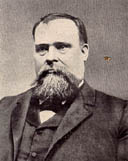The Fight for the Commission
Page 1 2 3 4 5 6
“Arrogant Capitalists and Powerful Corporations”
The lower rates did not win the Texas Traffic Association any fans in the Farmers’ Alliance. At its 1886 meeting, the Alliance demanded an end to the abuses of “arrogant capitalists and powerful corporations.” According to the Alliance, traditional American individualism was threatened by the growing monopoly power of eastern capitalists. The railroad laws on the books were toothless if there were no enforcement mechanisms. Without the protection of government enforcement, shippers were reluctant to file complaints against the railroads. How could an individual hope to prevail against a huge corporation with seemingly unlimited resources and the ability to retaliate?
Farmer outrage was fueled by the United States Supreme Court. In the Wabash case (Wabash, St. Louis & Pacific Railroad Company v. Illinois), the Court ruled that state decisions on railroad rates were not binding on interstate corporations. This rule invalidated the efforts of Texas and other states to set rates. The Wabash decision led to a renewal of calls for a strong railroad commission in Texas.
Another pivotal event of 1886 was the Great Southwest Strike. The Jay Gould-controlled line had fired a Marshall worker for his activities with the the Knights of Labor, a labor group. A strike to protest the action began in March, with workers demanding better working conditions and the establishment of regular paydays. Thousands of workers struck in Texas, Arkansas, Kansas, Missouri, and Illinois.
|

Labor unrest and dangerous working conditions continued for years to come, as seen in the aftermath of this 1912 explosion in San Antonio
|
Violence broke out after workers blocked tracks by uncoupling cars and seizing switch junctions. Gould brought in strikebreakers and Pinkerton detectives (Gould once famously remarked, “I can hire one-half of the working class to kill the other half.”). At Gould’s request, Governor John Ireland called out the Texas Rangers and the state militia to keep order in Fort Worth. Public opinion in Texas turned against the strikers because of the violence, and the strike lost support from the national Knights organization.
The strike was broken, its leaders were blacklisted from working for the railroads again, and the labor movement was dead in Texas until the turn of the century. In spite of the strike’s failure, it focused the attention of the public on the railroads and their business practices. A congressional committee investigating the strike held highly publicized hearings in Fort Worth, Marshall, Palestine, and other towns.
Enter Jim Hogg
James Stephen Hogg first became interested in the railroads and the effect they had on the average person when he was a crusading district attorney in East Texas.
 Read more about Jim Hogg and view pictures of him on our Portraits of Texas Governors site.
Read more about Jim Hogg and view pictures of him on our Portraits of Texas Governors site.
|

Jim Hogg became the public face of opposition to railroad abuses
|
Hogg saw first-hand communities that became ghost towns after the railroads bypassed them and local lines fell into the hands of Jay Gould’s empire. In 1886, Hogg was elected Attorney General of Texas and made railroad reform one of his top priorities.
At first, Hogg focused on bringing suits to force the railroads to comply with their charter provisions, such as finishing lines and keeping them maintained. The passage of the federal Interstate Commerce Act persuaded Hogg to bide his time before attempting more aggressive action. The federal act outlawed some of the most controversial practices of the railroads, including pooling, and the Texas Traffic Association promised “to comply in good faith.” Hogg confided to his friend C.W. Raines that the association was the prize he was after, writing, “…if I cannot beat them down, outright, I shall force them to wilt, wither, and dry up in the burning sunlight of justice while they are lying on and wearing me out.”
In 1888, Hogg successfully sued the Texas Traffic Association, charging the members with creating a monopoly and pool, preventing competition, and violating both their charters and the Texas Constitution. Specifically, Hogg charged that the Jay Gould-controlled Missouri, Kansas, & Texas Railway (nicknamed the Katy) had illegally acquired the East Line & Red River Railroad and leased the lines of the International & Great Northern, which were also both Gould lines.The Katy had been operating in Texas for years without a legal charter. Hogg won the suit, and the lease was cancelled. In this and several other suits, Gould was forced to return equipment that he had moved out of Texas and was blocked from dumping stocks and bonds of lines that he had acquired and then allowed to get run down.
Next >>
Page 1 2 3 4 5 6